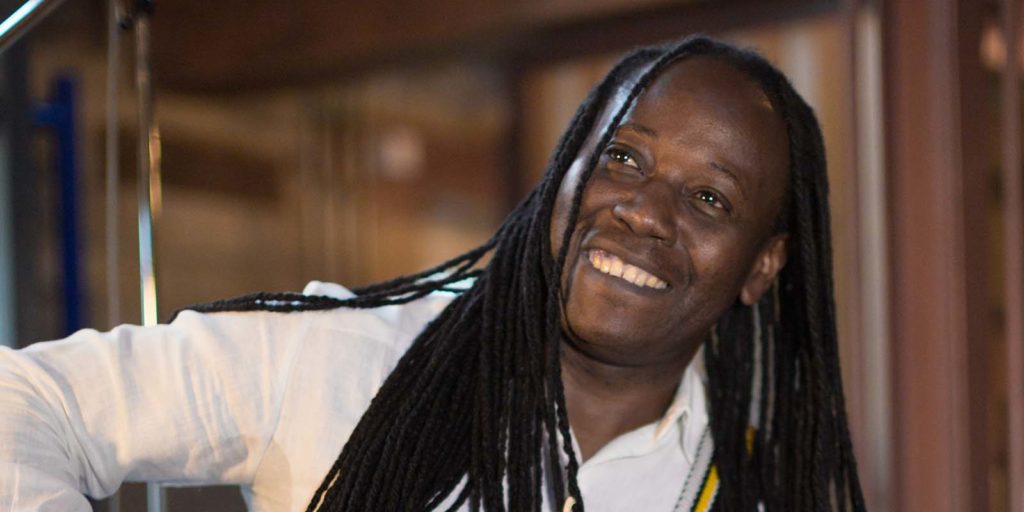Aurelio Martínez is a Honduran Garifuna singer-songwriter. To our uneducated ear, he sounds like an Afrobeat Bob Dylan with elements of surf guitar and something with the feel of Calypso.
Aurelio is a leading voice of the Garifuna people, speakers of the last living Indigenous Carib language. There is a vibrant Garifuna community in Crotona Park East, The Bronx.
Aurelio Martínez & the Garifuna Soul Band play Garifuna Folk, with NYC’s own Wabafu Garifuna Dance Company opening, for the World Music Institute at Le Poisson Rouge in Greenwich Village on Thu, Dec 16, 2021 at 7:30pm (6:30pm doors). worldmusicinstitute.org 🇭🇳|🇧🇿🇬🇹🇳🇮🇺🇸 garifunadancecompany.com
If you know any African Diaspora culture in the Caribbean, Brazil or Peru (Rumba, Méringue, Bomba, Cumbia, Tambor, Samba, Festejo), you will recognize parts of our culture in the Garifuna traditions. Each is unique, but we share the same roots in Mother Africa, so there are many similarities.
One thing we all have in common is that the traditions are designed to build community whether that is two people or a hundred. Syncopation is a signature of African Diaspora music traditions. It enables an infinite number of people to join in. Drumming, singing and dancing together makes everyone happy. You can’t help but smile.
About Aurelio Martinez
Aurelio Martinez was born into a musical family and became a talented drummer as a child. He learned his rhythms in the traditional way from his uncles and grandfather. Aurelio learned to sing from his mother. As a boy, Aurelio was already participating in Garifuna rituals which shouldn’t be surprising because we all do what our parents and families and communities do.
As a teenager he started to play in Latin bands. The first album Aurelia recorded with Grupo Garifuna de Honduras was Lita Ariran (JVC Records, 1995). It is a Garifuna classic.
Aurelio’s first solo recording Garifuna Soul (Stonetree Records, 2004) mixed Garifuna traditions with pop instrumentation. He later worked with Afropop legend Youssou N’Dour.
Martínez was the first Black Honduran congressman from 2006-2010. It’s a really notable achievement.
Aurelio came back to what he considers a roots Garifuna sound in Lándini (Real World Productions, 2014). His latest is Darandi, a greatest hits live collection.
Aurelio in New York City
Aurelio plays a free concert at the David Rubenstein Atrium at Lincoln Center Thursday, January 19, 2017 at 7:30pm.
Aurelio played Symphony Space in a show produced by the World Music Institute on November 22, 2014.
The Carib Were Fierce Fighters
In New York, we hear a lot about the Indigenous Taíno of Puerto Rico. The next people to make the journey out of what is now Venezuela up the Lesser Antilles were the Carib, for whom the Caribbean is named. They were famously fierce fighters.
What is now Culebra, Puerto Rico in the Spanish Virgin Islands was the northern border of Carib territory. The Taíno and Carib used to be in conflict, but when the Spanish colonizers came, they fought the Spaniards together from Culebra. The southern tip of the island is called Punto del Soldado. You can imagine warriors watching the sea from there.
Culebra is the beginning of the Lesser Antilles islands. You can see a difference between Puerto Ricans of the main island and the people of Culebra today. The culture looks to the Lesser Antilles, so you may see the Steel Pan of Trinidad, which you won’t see in the main island of Puerto Rico.
Garifuna Are the Last Carib Community
The story of Aurelio is tied to his people. Garifuna speakers are Indigenous Carib mixed with the African Diaspora from St. Vincent in the Lesser Antilles. They spoke a blend of Carib and Arawak. The Carib had conquered the Arawak and Carib men took Arawak women. So men spoke Carib and women spoke Arawak. Boys would be taught Carib when they came of age, so there was this unusual blend of the two languages.
Garifuna speakers are also mixed with West Africans who escaped Spanish shipwrecks and lived with the Carib.
The British could not defeat the Garifuna. They were basically deported in 1797 to coastal Honduras. From there Garifuna people have spread into Nicaragua, Guatemala, and Belize.
The language died out in the Antilles, so the Garifuna people are a unique remnant of the Indigenous Carib. New York City has the largest population of Garifuna outside of Central America.

